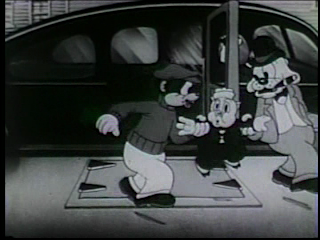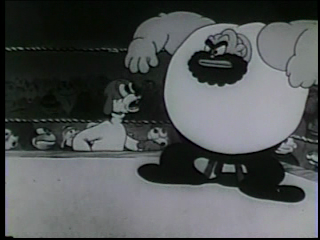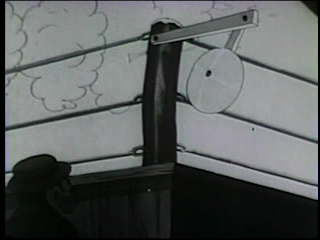1/9/1937 (according to the Grand Cartoon Database, IMDb and most other Internet sources)
DVD/BLU-RAY AVAILABILITY:
Porky Pig 101 (WHV 5-DVD set)
An as-good-as-it-gets version of this cartoon can be seen HERE (thanks for providing this, Devon Baxter!)
Avery and his unit continue to coast (but do so well) in this unaccountably rare and fairly minor cartoon. One deeply inspired sequence, worthy of a Jacques Tati, and an early vocal appearance by Mel Blanc--soon to finalize the Termite Terrace Dream Team with his great voice work and wit--makes this cartoon worthy of the name of Fred Avery.
This is one of the earlier Schlesinger cartoons to have been censored. One scene, or shot, was removed sometime in the 1940s. No one knows exactly why. Popular speculations include racial material (which seems unlikely, as racial stereotypes were vibrantly alive in the '40s) and a topical celebrity or sports caricature that no longer made sense, when and if this cartoon was reissued.
Sports cartoons are, by and large, the bane of the classic era of American studio animation. Aside from Friz Freleng's Baseball Bugs (1946), and the psychotic energy of Jack Kinney's 1945 Hockey Homicide, it's hard to think of a genuinely great cartoon with a sports theme.
Certainly, some of Avery's least interesting and successful cartoons (1939's Screwball Football and the 1944 MGM Batty Baseball) are sports-related.
Given the inherent absurdity of sports, to this non-sports person, there ought to be bushels of rich comedy in the topic. Perhaps the genre was--and is--held in too high reverence by the American masses to make outright mockery feasible.
Avery does see pockets of silliness in wrestling, and finds transcendent inspiration in one brief moment that saves this cartoon.
The cartoon's start is typical of Avery's early efforts--with stock devices from live-action features. Over Carl Stallings' robust music, we see newspaper presses roll, with a super-imposition that furthers the modernist bent.
Another superimposition reveals why all the hoo-hah:
Avery adds a super-superimposition that seals the deal in 14 seconds of screen time:
Anyone who knows Avery's comedic bent realizes that this will lead to some rapid-fire sight gags. We abruptly cut to a holy trinity of hitch-hiking bits. First is an extremely pliable Dachshund, abrim with eagerness:
anticipates a nightmarish image from Avery's controversial but masterful 1948 MGM cartoon, Half-pint Pygmy:
Avery then breaks the classic "rule of threes" with a fourth hitch-hike gag that's the funniest of the lot. A uniformed dog, with the muffled voice of a car radio, announces "Calling all cars... calling all cars... give me a ride, please..." in the expected monotone.
He immediately gets what appears to be a lift...
...until the jalopy falls apart.
In a form-follows-function bit, the ex-driver opens his suitcase...
...and sweeps the remains of what was once his car neatly inside.
He, now, is ready to join the line of eager-beaver hitch-hikers!
Back to Porky. He's approached by a more modern sedan...
"Where ya going, sonny?"
Still voiced by Joe Dougherty, Porky forces out that he's goin' to the "rasslin' match."
"So am I."
SLAM; vroom.
Porky's WTF expression is priceless.So far, the cartoon has provided its audience with screwball smart-assery, which is just fine. Now the plot literally drives into the picture, with its own subtitle:
"The Challenger" is a staple type of screwball comedy: the Greco-Russian refugee with an spellcheck-proof name. He exists to provide a bridge from Point A to Point B for our would-be hero.
As the smoke clears, we see a remarkable shot, from the champ's POV, as the car advances towards Porky. Avery, as we've seen, is fond of reproducing live-action visual effects and transitions in his cartoons. This brief shot is impressive. It gives the illusion of the limousine approaching through space towards PP.
Frank Tashlin is most often hailed as the director who brought live-action techniques into Warner Brothers cartoons. Avery had already achieved this several times before Tashlin made his first short for Schlesinger.
Unpronounceable uses his chauffeur's head like a microphone:
"Hey Joe. Peek opp dees leetle fallah."
All Avery autos are equipped with great brakes. Avery throws in some multi-plane effects here, just to show off. There's no reason to include them otherwise.Porky asks Unpronounceable's name, and he swells with pride and fury.
I can't understand a word this fellow says, but the poses, attitudes and movement are dynamite--especially when he leans into deep focus, seeming to burst out of the screen. Avery and Tashlin loved to do this, and the effect must have been novel--and startling--to their first audiences.
Cut to a moment straight out of a mid-'30s Frank Capra feature for Columbia Pictures. Long shot of a small-town sports arena; cut to two shot of fight promoter and manager pacing nervously, awaiting Unpronounceable's arrival.
Like any good automobile in an Avery cartoon, the limo bends around the corner as it turns...
then expands as it approaches its stopping point.
Avery borrowed this bendy-car effect from early animation. Like much of his humor, it was a device that had been used, but not thoroughly understood, by previous users. Two still frames from the 1932 Terrytoon Hook and Ladder #1 show the effect used unselfconsciously:
Much of Avery's genius was in his conscious embrace of these gags and gimmicks. He came to own devices that were just throwaway moments in earlier animation (and live action). His lexicon as a film-maker is almost entirely based on reflective revisions of what others had already done.
Unpronounceable now literally steps out of the picture, and sets up a perfect screwball comedy of assumed identity.
Yep: Porky's mistaken for the Russian giant, and rushed into the stadium.
Imminent doom, voiced by Tedd Pierce, awaits Porky within:
The champ, Man-Mountain, is informed that his opponent has arrived.
The announcer (voiced by Mel Blanc) gets the bout started.
Man-Mountain weighs 406 lb., we now learn!
The MC points to an empty corner...
while Porky, still not hep to the jive, is raised from below to the canvas.
Here comes the depressing section of a sports-themed comedy: the quivering underdog versus the mindless beast. This scenario smelled of mothballs in 1936, and time hasn't been kind to it, despite countless uses since then,
To Avery's credit, he keeps an eye on the potential for anarchy, and doesn't subject Porky to much harm...
Porky sees Man-Mountain and does a nice early Avery shock-take.
I imagine I'd be frightened, too if I laid eyes on this...
Porky comes to, and, as would any sane being in this scenario, seeks quick escape! In the process, we hear the earliest example of Mel Blanc's sped-up "woo hoo"s, soon to embody the life spirit of one Daffy Duck,
Man-Mountain is ready to maul our diminutive hero.
He yanks on the ropes and draws Porky into his gentle, caressing hands.
Man-Mountain plays an old child game called "One, Two, Three O'Leary." Voiced by Tedd Pierce, this moment is incongruously funny, and reassures us we're not going to see another miserable sports-themed massacre.
The round form of Man-Mountain makes for some marvelous animation poses that violate one prime rule of the art. These absolutely do not read as silhouettes. Whatever occurs happens within the oval of the wrestler's form. The contrast of black and white makes it easy to follow the internal line of action.
A 1937 sports cartoon is the last place on earth you'd expect to find a moment of trans-formative surrealism. Thanks to a pipe-smoking hound, this wrestling match morphs into a train voyage!
Say--this looks like fun! Real railroad sound effects, too! Might as well become a train!
Now an official locomotive, Man-Mountain clears the canvas of referee and wrestling opponent!
Before these living boxcars join, there's a nice piece of toward-the-screen animation, which reminds us of the depth of space in the wresting ring.
Linkage is achieved, and any pretense of a rasslin' match is forgotten, for the moment...
As they round the bend, the transformation is complete. The time-keeper turns the gong into a railroad signal...
a candy butcher peddles "souvenirs, postcards, pillows, magazines, Cracker Jack..." and so on...
a thirsty traveler tries to pour a cup on water while the "train" rocks and heaves...
Here, we reach the point where the excised footage was apparently cut.
In the surviving print, a clean scene change occurs between an insert shot of the live locomotive and the passive passenger of one of Avery's most inspired WTF?!? moments:
Mark Kausler, in a kind answer to my questions about who-animated-what, offers a ray of light on where the cut material was, originally, in this cartoon, and what it might have contained. I quote: "In the Guild print I have [of Porky the Wrestler] there is the beginning of a musical bit clipped just before the scene where a spectator opens a window shade to see scenery going by. The singers are singing lyrics: "She was gone..." and then the soundtrack cuts off."
That music is no more in the print shown by the Cartoon Network in the 1990s and 2000s. Kausler's print reveals a snippet of what's missing. It's not enough to know what the trimmed material was, or what might have caused it to be cut. A grain of information such as this is helpful, although the result is still baffling. Thank you, Mark, for this addition to animation history--one of so many Mark has made over the years.
Back to our magic moment: the slightly worried-looking canine is compelled to lift the shade. He sees passing scenery (which includes railroad SFX and animated passing telegraph poles).
He blinks twice...
does a late-blooming take...
By now, the spell is dimming, and as Porky gets out of sync with the train shtick, reality returns with a literal collision.
Enraged that Porky "don't wanna play choo-choo" no more, Man-Mountain returns to Beast Mode.
You know that when Avery advertises an action with a subtitle that something's going to happen.
And, yes, it's what you thought would probably happen...
but it's executed with some nice blur-line animation.
Porky comes to, does another nice horror-take, and seeks asylum under the time-worn canvas.
Man-Mountain intercedes, painfully:
Hoisted on his own petard, Man-Mountain is counted out by the ref, leaving Porky a dazed and physically shaken winner-by-default. Man-Mountain and the audience chime in on the syncopated ten-count.
"Tha winnah!"
We end on a lame sight-gag that anticipates the similar daft finales of Dick Lundy-directed Walter Lantz cartoons, a decade later.
1937 will be a game-changing year for the Fred Avery unit. Porky the Wrestler has moments of charm--and one truly transcendent sequence--but it's clear that some of the daredevil spirit of the earlier cartoons has been toned down. It's not gone--just resting up.
The Avery-at-Schlesinger dream team is now fully assembled, save for animator Irv Spence. The Avery unit was clearly capable of making better films than this, as they'd soon prove. Of its dismal genre, this is among the better sports-themed cartoons. In comparison to the 1938 Ben Hardaway-Cal Dalton directed Merrie Melodie, Count Me Out, this seems like a mini-masterpiece.
Avery and unit are on the verge of a major breakthrough--one that probably hasn't yet dawned on them. Watch this space for further revelations!
NEXT UP: bull-fighting "fun" with Picador Porky.






























































































































































































































































What is the song they use in the opening credits on this one? I prefer it to "Merry Go Round Broke Down" and "Merrily We Roll Along"
ReplyDeleteThis is absolutely one of my all time favorites. The "choo-choo" scene goes on too long, but I even find my impatience with it funny. So they really knew what they were doing there.
ReplyDeleteBut NOTHING is funnier than when the English-butchering Russian wrestler the un-pronounceable name in the limo wraps up his speech looking right into the camera and, boasts "I fight ANYONE my HEAVY." I kinda wish he hadn't "dropped out" of the cartoon so early. He is hysterical. "Hey Joe. Peek up dis little fallo."
Ben
Well done with this scene by scene breakdown.
Hello from Belgium,
ReplyDeleteI found these one :
https://www.dailymotion.com/video/x61tqvm